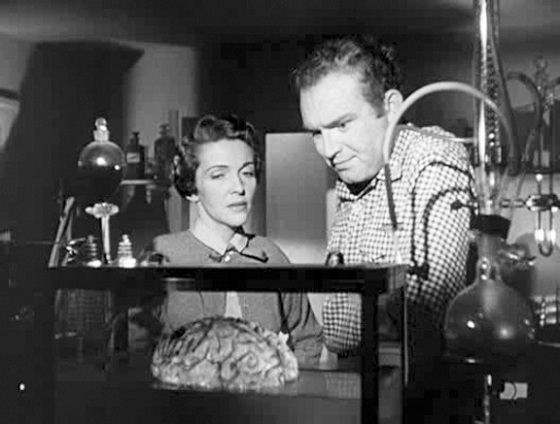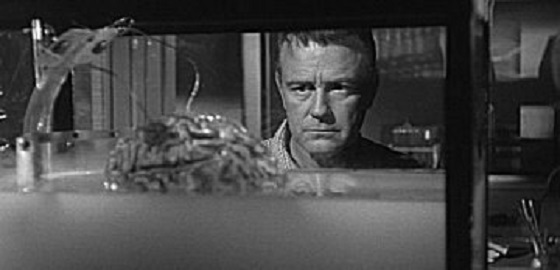Science Fiction movies from the fifties have a reputation for being simple creature features, films with names like Beast from Haunted Cave, The Mole People, and It Came from Beneath the Sea. Not as plentiful, but still just as popular, are the movies from the era where man is the monster, films such as A Bucket of Blood and The Black Sleep. Sometimes, however, the villain is a combination of both. In 1953, one of the most creative sci-fi movies of the sixties was made, a clever little movie called Donovan’s Brain.

Donovan’s Brain is the story of Dr. Patrick Cory (Lew Ayres from Salem’s Lot) who, along with his wife Janice (Nancy Davis, who would later become first lady Nancy Reagan) and his assistant Dr. Frank Schratt (Shock Corridor’s Gene Evans), have conducted successful experiments where they have been able to keep the brain of a monkey alive outside of its body. Their lab is in a remote location, and when a plane crashes nearby, Dr. Cory, who happens to be the closest physician to the crash site, is asked to help with the survivors. It turns out that the only survivor is a millionaire named W.H. Donovan, but he is in such bad shape that he dies shortly after arriving at Dr. Cory’s lab. Dr. Cory and Dr. Schratt have the crazy idea to hook Donovan’s brain up to their machine, and it works; they are able to keep the brain functioning after Donovan’s body is gone. Soon enough, the brain starts to telepathically communicate with Dr. Cory. At first, Dr. Cory just seems to be getting Donovan’s affairs in order, but eventually, the brain completely possesses Dr. Cory and he starts to orchestrate the deaths of Donovan’s enemies. Dr. Schratt and Jan have to figure out how to end the brain’s influence over Dr. Cory before he/it can harm anyone else.

The novel on which Donovan’s Brain was based was written by Curt Siodmak, an accomplished screenwriter who wrote many classic screenplays for Universal Studios, including The Wolf Man and the various sequels for The Invisible Man. The novel has been adapted for the screen three times – in 1944 as The Lady and the Monster, in 1962 as The Brain, and in this 1953 version – as well as alluded to in several films like The Brain that Wouldn’t Die and The Man with Two Brains. The screenplay for this adaptation of Donovan’s Brain was written by director Felix Feist (who would go on to have a career in television, directing episodes of “The Outer Limits” and “Voyage to the Bottom of the Sea”) and Hugh Brooke (Dark World), and it skillfully walks the line between a sci-fi picture and a film noir thriller. It’s a much slicker film than most fifties B-movies, showing off Feist’s knack for storytelling, yet still has the sensationalistic elements of, well, a movie with a killer brain. It may be classified as a sci-fi/horror film, but Donovan’s Brain is much more than that.

Lew Ayres has a field day with Donovan’s Brain. His character, Dr. Cory, is clearly the lead in the film, but Ayres plays him like two different characters. At the beginning of the film, he is the kind, altruistic doctor who uses science for the good of mankind. Once Donovan’s brain starts to take control of him, he changes; he becomes cold and calculating, the human antagonist in the film. Ayres plays both sides of Dr. Cory remarkably well, giving the character the Jekyll-and-Hyde split personality that he needs in order to be effective. The audience is sympathetic towards Dr. Cory, but not towards the brain that controls him. Lew Ayres performance conflicts the audience and, therefore, it is one of the most memorable elements of Donovan’s Brain.

Of course, the real antagonist in Donovan’s Brain is the brain itself, and that is where the movie shows its science fiction roots. Designed by Harry Redmond, Jr. (who did special effects for television shows like “The Outer Limits” and “Science Fiction Theater,” as well as for such movies as King Kong and The Most Dangerous Game), the actual brain is a rubber prop in an aquarium, floating in liquid, with electrodes attached to it. The latex cranium is hooked up to some kind of air pump, allowing it to visually pulsate as it “thinks” its way into Dr. Cory’s mind. The effect sounds silly, and it actually kind of is, but it brings a bit of B-movie style to an otherwise straight picture. The brain is obviously a vital plot device in Donovan’s Brain, and Redmond’s prop is a perfectly sinister representation of it.

The musical score for Donovan’s Brain sounds more like the soundtrack to a crime drama or a western than the music to a horror film, but it is nonetheless effective. The score, written by popular music songwriter and organist Eddie Dunstedter, is very melodramatic, full of heavy horn swells and loud orchestra crescendos. There are no synthesizers, mellotrons, or theremins on the soundtrack, so it doesn’t sound like a typical horror/sci-fi score. The music is a cinematic mix of big band jazz and pop classical, lending itself well to the hybrid style of the film. It may not scare anyone, but Dunstedter’s score for Donovan’s Brain helps to bring out both the suspense and the action in the film.

There were a ton of campy low-budget movies made in the fifties, so anything with a sci-fi or horror genre label was pigeonholed as a B-movie. However, all B-movies were not totally cheesy, and Donovan’s Brain proves that fact admirably.
